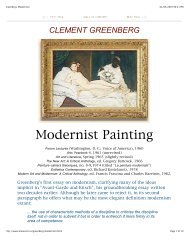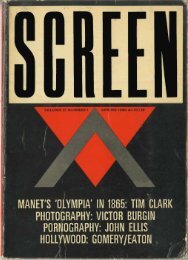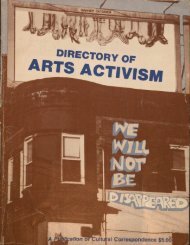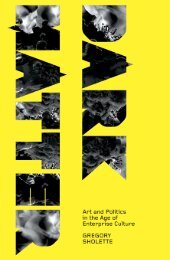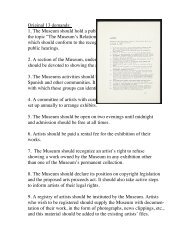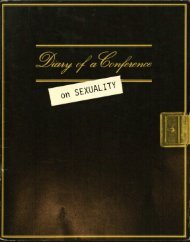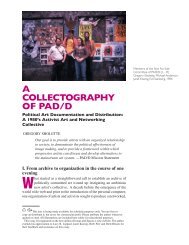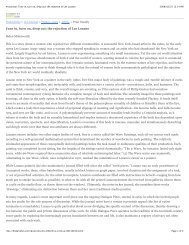Postscript to the Past: Notes Toward a History of Community Arts
Postscript to the Past: Notes Toward a History of Community Arts
Postscript to the Past: Notes Toward a History of Community Arts
You also want an ePaper? Increase the reach of your titles
YUMPU automatically turns print PDFs into web optimized ePapers that Google loves.
<strong>Postscript</strong> <strong>to</strong> <strong>the</strong> <strong>Past</strong>: <strong>Notes</strong> <strong>Toward</strong> a His<strong>to</strong>ry <strong>of</strong> <strong>Community</strong> <strong>Arts</strong>2008/02/22 10:38 AMcultural development. When <strong>the</strong> first 75 CETA arts jobs were created in1973 (<strong>the</strong> brains<strong>to</strong>rm <strong>of</strong> an inventive NAP staffer who happened <strong>to</strong> haveinterned in Washing<strong>to</strong>n), 3,000 unemployed artists showed up <strong>to</strong> apply for<strong>the</strong> <strong>the</strong>m. After that, <strong>the</strong> phenomenon <strong>of</strong> CETA arts spread across <strong>the</strong>country like wildfire. Department <strong>of</strong> Labor <strong>of</strong>ficials estimated that over $200million had been allocated <strong>to</strong> <strong>the</strong> arts through CETA in fiscal year 1979alone.By <strong>the</strong> late '70s, community arts groups across <strong>the</strong> country were usingCETA money and just about every o<strong>the</strong>r form <strong>of</strong> federal funding <strong>to</strong> financean array <strong>of</strong> programs that put people <strong>to</strong> work in community culturaldevelopment. To illustrate, in mid-1980, just before Ronald Reagan'selection as president, Baltimore's Theatre Project not only maintained itscore program presenting innovative <strong>to</strong>uring performances; it was also one<strong>of</strong> <strong>the</strong> leading community arts institutions in <strong>the</strong> country: CETA support aswell as some <strong>Community</strong> Development Block Grant money underwrote itsneighborhood circus; city Department <strong>of</strong> Housing and <strong>Community</strong>Development money financed a performance piece involving kids in <strong>the</strong>campaign <strong>to</strong> eradicate rats; and National Endowment for <strong>the</strong> Humanitiesgrants enabled a production based on <strong>the</strong> reminiscences <strong>of</strong> Baltimore's oldtimeneighborhood residents, compiled through a massive oral his<strong>to</strong>ryproject. The Theatre Project was especially successful at "working <strong>the</strong>agencies" <strong>to</strong> secure this kind <strong>of</strong> funding, but was by no means <strong>the</strong> onlygroup doing so. The moment was opportune: public agencies havingnothing formal <strong>to</strong> do with <strong>the</strong> arts were seeing community arts as valid<strong>to</strong>ols for engaging communities in self-education and self-activation. It's notthat <strong>the</strong> federal government was especially more enlightened and farsighted<strong>the</strong>n than now; but money was available and community artsprojects <strong>of</strong>fered highly visible, <strong>of</strong>ten effective and always colorful ways <strong>to</strong>spend it.By <strong>the</strong> time Reagan had been in <strong>of</strong>fice for a year, all this had changed.Here's what Don Adams and I wrote about <strong>the</strong> Theatre Project in <strong>the</strong> March1982 issue <strong>of</strong> Cultural Democracy: "Deep staff reductions at <strong>the</strong> TheatreProject have virtually eliminated <strong>the</strong> Baltimore group's community serviceprograms: The Rat Squad...was ended in mid-March...because <strong>of</strong><strong>Community</strong> Development Block Grant reductions; all but two members <strong>of</strong><strong>the</strong> Baltimore Voices oral his<strong>to</strong>ry company have been laid <strong>of</strong>f and in August<strong>the</strong> project's NEH funding expires....[T]he community program...is largelygone."Money Changes EverythingAt this point you may be wondering, why so much <strong>to</strong> say about funding? Is<strong>the</strong> his<strong>to</strong>ry <strong>of</strong> funding <strong>the</strong> same as <strong>the</strong> his<strong>to</strong>ry <strong>of</strong> <strong>the</strong> movement?If we're talking about <strong>the</strong> last 25 years, I'm afraid so. All over <strong>the</strong> country,<strong>the</strong> s<strong>to</strong>ry was <strong>the</strong> same. Energetic, idealistic, socially conscious artists weredriven by <strong>the</strong> forces that propelled "The '60s" in<strong>to</strong> being: rebellion againstsocially enforced conformity, recognition <strong>of</strong> pressing social problems thathad been obscured by <strong>the</strong> quietism <strong>of</strong> <strong>the</strong> Red Scare and its aftermath, and<strong>the</strong> flowering <strong>of</strong> cultural identity in racial, ethnic and sexual liberationmovements. The energy <strong>to</strong> develop a community arts practiceunquestionably came from those artists; <strong>the</strong> seeds that sprouted incommunity arts activity came from <strong>the</strong>ir own communities. But whatnourished those seeds was public money—after all, what else was <strong>the</strong>re?Most <strong>of</strong> <strong>the</strong> neighborhoods housing community arts programs were poor;except for a few communities, <strong>the</strong>re was almost no private philanthropyactive in <strong>the</strong> field; and people's ability <strong>to</strong> work for nothing and with nothingwas understandably limited. Most <strong>of</strong> <strong>the</strong> time, funding resulted from aconvergence <strong>of</strong> interests: <strong>the</strong> government wanted <strong>to</strong> keep kids busy during<strong>the</strong> summer, <strong>of</strong>fer jobs <strong>to</strong> <strong>the</strong> hard-core unemployed, or encouragecommunity life in depressed neighborhoods, and community artists sawhttp://www.communityarts.net/readingroom/archivefiles/1999/12/postscript_<strong>to</strong>_t.phpPage 3 <strong>of</strong> 7
<strong>Postscript</strong> <strong>to</strong> <strong>the</strong> <strong>Past</strong>: <strong>Notes</strong> <strong>Toward</strong> a His<strong>to</strong>ry <strong>of</strong> <strong>Community</strong> <strong>Arts</strong>2008/02/22 10:38 AMcommunity life in depressed neighborhoods, and community artists sawways <strong>to</strong> make good use <strong>of</strong> <strong>the</strong> money set aside for <strong>the</strong>se purposes in <strong>the</strong>service <strong>of</strong> <strong>the</strong>ir culturally democratic aims. This was not arts funding per se,but it supported arts work. The tide <strong>of</strong> public money that flowed down <strong>the</strong>community arts creek beginning in <strong>the</strong> late '60s was used almostexclusively <strong>to</strong> finance jobs in a labor-intensive field that was well suppliedwith eager and able workers. When <strong>the</strong> money was cut <strong>of</strong>f, <strong>the</strong> streamslowed <strong>to</strong> a trickle: people lost <strong>the</strong>ir jobs, whole organizations folded orwere forced <strong>to</strong> cut back <strong>to</strong> a point just this side <strong>of</strong> disappearance.Which brings us <strong>to</strong> <strong>the</strong> last ten years. Without public service employmentprograms, with no funding programs dedicated <strong>to</strong> community arts support,development in <strong>the</strong> field has been slow. Some <strong>of</strong> those who lost <strong>the</strong>ir jobsor organizations in <strong>the</strong> early '80s tried <strong>to</strong> adopt <strong>the</strong> rhe<strong>to</strong>ric <strong>of</strong> <strong>the</strong> "Reaganrevolution," refocusing <strong>the</strong>ir work <strong>to</strong>ward <strong>the</strong> market economy. Somemanaged <strong>to</strong> make a living this way, but what <strong>the</strong>y were doing could hardlybe called community arts. O<strong>the</strong>rs made <strong>the</strong> best <strong>of</strong> less-than-idealsituations: for instance, most state arts agencies continued operatingartists' residency programs. These were usually oriented <strong>to</strong>ward <strong>the</strong>conventional residency model, a short-term project in which students orsenior citizens or o<strong>the</strong>r groups <strong>of</strong> people are thought <strong>to</strong> derive benefitsimply from proximity <strong>to</strong> an artist—from attending informal performances,for instance. But clever community artists have managed <strong>to</strong> do a great dealwith residency programs despite <strong>the</strong>ir limitations, using <strong>the</strong>m <strong>to</strong> createopportunities for cultural development and community collaboration. Thegroups with <strong>the</strong> most tenacity and shrewdest fundraising have carried onby adjusting <strong>the</strong>ir language <strong>to</strong> <strong>the</strong> times without surrendering <strong>the</strong> corevalues <strong>of</strong> <strong>the</strong>ir practice. But it would be unreasonable <strong>to</strong> expect a greatleap in community arts' development in such an inhospitable period as <strong>the</strong>Reagan-Bush era.Recently, <strong>the</strong>re have been signs <strong>of</strong> hope. People in <strong>the</strong> field are againtalking about it, as this issue <strong>of</strong> High Performance demonstrates. A fewmajor foundations have hinted at new interest in community arts work.With a new administration in Washing<strong>to</strong>n and a post-Cold War zeitgeist,<strong>the</strong>re may again be some small openings that community artists canexploit. If this happens—if people start identifying <strong>the</strong>mselves ascommunity artists again, if <strong>the</strong>y articulate <strong>the</strong>ir own working principles andassert <strong>the</strong>ir own values and methods, if <strong>the</strong>y demand funding programstailored <strong>to</strong> <strong>the</strong>ir practice ra<strong>the</strong>r than vice versa, if new opportunities arise <strong>to</strong>meet <strong>to</strong>ge<strong>the</strong>r and discuss <strong>the</strong> nature <strong>of</strong> <strong>the</strong> work, <strong>to</strong> train younger peoplein it and thus express some hope for a future—if <strong>the</strong>se things happen, <strong>the</strong>nit will be very handy <strong>to</strong> know something about <strong>the</strong> his<strong>to</strong>ry that led <strong>to</strong> thismoment, if for no o<strong>the</strong>r reason than <strong>to</strong> avoid repeating its mistakes.Sources and TributariesWhere can we look for community arts' antecedents? I want <strong>to</strong> suggest anumber <strong>of</strong> traceable influences, at <strong>the</strong> same time warning that this is by nomeans a definitive list.<strong>Community</strong> arts are rooted in anti-Romantic thinking about <strong>the</strong> arts:against <strong>the</strong> notion <strong>of</strong> <strong>the</strong> artist as working for <strong>the</strong> approval and reward <strong>of</strong> adisembodied marketplace <strong>of</strong> <strong>the</strong> elite; and in favor <strong>of</strong> <strong>the</strong> idea <strong>of</strong> <strong>the</strong> artistas an integral part <strong>of</strong> community life, working with and for ordinary peopleand rewarded, as o<strong>the</strong>r workers hope <strong>to</strong> be, with a decent living and <strong>the</strong>rights and responsibilities <strong>of</strong> citizenship. A certain nostalgia for tribal andpre-Industrial Revolution agrarian societies pervades <strong>the</strong> movement; forWilliam Morris' call for artisanship; for <strong>the</strong> sort <strong>of</strong> artist-as-worker stanceadopted by <strong>the</strong> activist artists' groups <strong>of</strong> <strong>the</strong> '30s and most fully expressedin <strong>the</strong> proceedings <strong>of</strong> <strong>the</strong> first American Artists Congress <strong>of</strong> 1936. Wherenostalgia is present, <strong>of</strong> course, even among anti-Romantics <strong>the</strong>re is danger<strong>of</strong> romanticization.http://www.communityarts.net/readingroom/archivefiles/1999/12/postscript_<strong>to</strong>_t.phpPage 4 <strong>of</strong> 7
<strong>Postscript</strong> <strong>to</strong> <strong>the</strong> <strong>Past</strong>: <strong>Notes</strong> <strong>Toward</strong> a His<strong>to</strong>ry <strong>of</strong> <strong>Community</strong> <strong>Arts</strong>2008/02/22 10:38 AM<strong>of</strong> romanticization.The period between <strong>the</strong> two world wars was a tremendously fruitful one forsocially conscious artists, both in terms <strong>of</strong> thinking and <strong>of</strong> practice. Thecommunity muralists <strong>of</strong> <strong>the</strong> '60s and '70s were strongly inspired by <strong>the</strong>irforebears, <strong>the</strong> Mexican muralists <strong>of</strong> <strong>the</strong> '20s and beyond, who also inspiredGeorge Biddle <strong>to</strong> return <strong>to</strong> <strong>the</strong> States and suggest <strong>to</strong> FDR in 1933 that heand a team <strong>of</strong> muralists should embellish <strong>the</strong> new Justice Departmentbuilding in Washing<strong>to</strong>n. FDR already knew a little bit about public artsprograms: when he was governor <strong>of</strong> New York, <strong>the</strong> state relief direc<strong>to</strong>r hadallocated funds <strong>to</strong> <strong>the</strong> College Art Association <strong>to</strong> employ 100 artists insettlement houses. Biddle's suggestion started a chain <strong>of</strong> events thatcreated <strong>the</strong> New Deal cultural programs <strong>of</strong> <strong>the</strong> Roosevelt administration,including <strong>the</strong> Federal Theatre Project, <strong>the</strong> Federal Writers Project and o<strong>the</strong>rprograms which, at <strong>the</strong>ir peak in 1936, employed 40,000 artists. Everycommunity artist I have met becomes misty-eyed at <strong>the</strong> mention <strong>of</strong> <strong>the</strong>Works Progress Administration (WPA). It's not that all 40,000 wereemployed as community artists (though some were, for instance working innew black <strong>the</strong>aters, foreign-language <strong>the</strong>aters and rural programs set up <strong>to</strong>provide assistance for amateur <strong>the</strong>ater) that brings a tear <strong>to</strong> <strong>the</strong> eye, it'sthat a positive social role for artists was conceived and supported by <strong>the</strong>public sec<strong>to</strong>r. As Federal Art Project direc<strong>to</strong>r Holger Cahill put it, "It hasbrought <strong>the</strong> artist closer <strong>to</strong> <strong>the</strong> interests <strong>of</strong> a public which needs him. And ithas made <strong>the</strong> artist more responsive <strong>to</strong> <strong>the</strong> inspiration <strong>of</strong> <strong>the</strong> country, andthrough this <strong>the</strong> artist is bringing every aspect <strong>of</strong> American life in<strong>to</strong> <strong>the</strong>currency <strong>of</strong> art." The WPA was ended by a presidential proclamation in1942, <strong>the</strong> victim <strong>of</strong> censorship, <strong>the</strong> Red Scare and war preparations, andthat's part <strong>of</strong> <strong>the</strong> community arts legacy <strong>to</strong>o.Some hardy remnants <strong>of</strong> prewar cultural activism survived in<strong>to</strong> <strong>the</strong> postwarperiod, notably in rural areas—<strong>the</strong> Highlander Folk School in Tennessee, forinstance, and some arts extension agencies established before <strong>the</strong>Depression. For example, Wisconsin's arts extension, under <strong>the</strong> leadership<strong>of</strong> Bob Gard, invited people <strong>to</strong> send in <strong>the</strong>ir poems and s<strong>to</strong>ries so <strong>the</strong>ycould engage in critical correspondence with pr<strong>of</strong>essional writers; in 1958<strong>the</strong>y began <strong>to</strong> publish <strong>the</strong> journal <strong>Arts</strong> in Society, which <strong>to</strong>ok up many <strong>of</strong><strong>the</strong> issues community artists face <strong>to</strong>day.But <strong>the</strong> strongest boost <strong>to</strong> community arts came from <strong>the</strong> newly-enlivenedactivism <strong>of</strong> <strong>the</strong> '60s, which brought <strong>to</strong>ge<strong>the</strong>r constituencies hungry formeaning and action. As John O'Neal put it at a meeting <strong>of</strong> <strong>the</strong>Neighborhood <strong>Arts</strong> Programs National Organizing Committee in 1982, "Ouroverall objective in <strong>the</strong> Free Sou<strong>the</strong>rn Theatre was <strong>to</strong> support and reinforce<strong>the</strong> aims and purposes <strong>of</strong> <strong>the</strong> black liberation struggle....So <strong>the</strong> most validtimes...were when we were part <strong>of</strong> a broad social movement, <strong>the</strong> broadmovement that in fact created us and made it possible for us <strong>to</strong> exist. AndI would even go so far as <strong>to</strong> say it made it possible for what is generallycalled `alternative arts' <strong>to</strong> exist."<strong>Community</strong> artists are not usually jet-setters, but much has beenaccomplished by a few people who've been able <strong>to</strong> travel. During <strong>the</strong> '70s,for instance, quite a few British community artists visited <strong>the</strong> U.S., bringingnews <strong>of</strong> <strong>the</strong>ir own practice, which was well developed and relatively wellsupported by public funding. Some people were inspired by <strong>the</strong> "<strong>to</strong>wnartist" model pioneered by Scots artist David Harding, in which acommunity more or less adopted an artist who lived <strong>the</strong>re for an extendedperiod, <strong>of</strong>ten years, working collaboratively with community members onprojects which serve <strong>the</strong>ir needs, from a pageant or his<strong>to</strong>ry play <strong>to</strong>architectural embellishments and playground sculptures. O<strong>the</strong>rs wereimpressed with <strong>the</strong> open-ended nature <strong>of</strong> British community arts practice:because community arts groups were able <strong>to</strong> obtain general operatingsupport, <strong>the</strong>y could enter in<strong>to</strong> free-form collaborations with communitieshttp://www.communityarts.net/readingroom/archivefiles/1999/12/postscript_<strong>to</strong>_t.phpPage 5 <strong>of</strong> 7
<strong>Postscript</strong> <strong>to</strong> <strong>the</strong> <strong>Past</strong>: <strong>Notes</strong> <strong>Toward</strong> a His<strong>to</strong>ry <strong>of</strong> <strong>Community</strong> <strong>Arts</strong>2008/02/22 10:38 AMsupport, <strong>the</strong>y could enter in<strong>to</strong> free-form collaborations with communitieswithout pressure <strong>to</strong> come up with finished products on deadline.From Europe came <strong>the</strong> notion <strong>of</strong> <strong>the</strong> animateur, <strong>the</strong> artist-organizer whoseaim it is <strong>to</strong> vitalize community cultural life and assist people in becomingactive cultural crea<strong>to</strong>rs. From Africa, Asia and Latin America came news <strong>of</strong>artists working in cultural development in post-colonial situations. In 1980,for example, when Marty Ardren helped bring Jacob Sou <strong>of</strong> <strong>the</strong> RegionalCultural Action Center <strong>to</strong> <strong>the</strong> U.S. from his base in Togo, community artistsin this country saw <strong>the</strong> parallels <strong>to</strong> <strong>the</strong>ir own circumstances. As Jacobdescribed his aims: "I didn't study African his<strong>to</strong>ry in school. I studiedFrench his<strong>to</strong>ry, and because it wasn't my country, I couldn't keep it....Idon't know that much about African his<strong>to</strong>ry—I have <strong>to</strong> learn it, after school.So we try <strong>to</strong> teach people `what is Africa?' `What are African cus<strong>to</strong>ms?'And generally, <strong>the</strong>y are learning it for <strong>the</strong> first time." In describing <strong>the</strong> basis<strong>of</strong> his training program, Jacob explained <strong>to</strong> trainees: "you won't be just anartist any more. You are, but now you have <strong>to</strong> work for <strong>the</strong> wholecommunity....You shouldn't go <strong>the</strong>re and try <strong>to</strong> do what you would like <strong>to</strong>do, but help <strong>the</strong> community do what <strong>the</strong>y want <strong>to</strong> do."During <strong>the</strong> '70s and '80s, liberating education and liberation <strong>the</strong>ology werestrong influences, sometimes in art-shaped packages (in <strong>the</strong>ater, <strong>the</strong> work<strong>of</strong> Augustin Boal and Alan Bolt, for example, who visited this country andmade contact with a great many people involved in communityperformance), but <strong>of</strong>ten as general philosophical principles extrapolated <strong>to</strong>arts work. When Paulo Freire described <strong>the</strong> act <strong>of</strong> self-liberation as learning<strong>to</strong> speak with one's own voice and say one's own words, community artistsaround <strong>the</strong> country heard his words as validation <strong>of</strong> <strong>the</strong>ir own practice, andmany <strong>of</strong> <strong>the</strong>m explored fur<strong>the</strong>r what he had <strong>to</strong> say. Ross Kidd emerged on<strong>the</strong> North American scene in 1982 as a veteran <strong>of</strong> popular <strong>the</strong>aterexperiments in Botswana and a founder <strong>of</strong> <strong>the</strong> Third World Popular TheatreNetwork, which defined popular <strong>the</strong>atre as "`committed' <strong>the</strong>atre, a <strong>the</strong>atre<strong>of</strong> oppressed groups and classes which works in support <strong>of</strong> <strong>the</strong> interestsand struggles <strong>of</strong> those groups and classes...it is part <strong>of</strong> a conscious process<strong>of</strong> social transformation....It is a means <strong>of</strong> deepening critical consciousness,provoking discussion <strong>of</strong> issues, examining alternative courses <strong>of</strong> action, andmobilizing people for struggle. At best it is more than <strong>the</strong>atre for <strong>the</strong>people; it is <strong>the</strong>atre by <strong>the</strong> people enabling <strong>the</strong>m, through <strong>the</strong> process <strong>of</strong>making <strong>the</strong>atre, <strong>to</strong> express <strong>the</strong>ir concerns, define <strong>the</strong>ir situation, andstrategize for action."By <strong>the</strong> mid-'80s, it was possible <strong>to</strong> see a tributary flowing <strong>the</strong> o<strong>the</strong>r way,from <strong>the</strong> heart <strong>of</strong> community arts work in<strong>to</strong> o<strong>the</strong>r areas <strong>of</strong> <strong>the</strong> arts. A greatdeal <strong>of</strong> installation and performance art since <strong>the</strong>n appears <strong>to</strong> be influencedby community arts, relying as it does on <strong>the</strong> active participation <strong>of</strong>nonartists and focusing as it does on provocation, poking at social sorepoints. I suppose High Performance, as <strong>the</strong> site <strong>of</strong> a convergence between<strong>the</strong>se two tendencies, is <strong>the</strong> fitting host for any dialog that does take placebetween <strong>the</strong>m, which brings us back <strong>to</strong> <strong>the</strong> present. As for <strong>the</strong> his<strong>to</strong>ry <strong>of</strong><strong>the</strong> '90s, it's yet <strong>to</strong> be made.Arlene Goldbard is a partner in Adams & Goldbard, cultural and organizational developmentconsultants; she frequently writes and speaks on cultural politics. Adams and Goldbard'sbook Crossroads: Reflections on <strong>the</strong> Politics <strong>of</strong> Culture is available for $13.95 postpaid fromDNA Press, Box 404, Talmage, CA 95481."<strong>Postscript</strong> <strong>to</strong> <strong>the</strong> <strong>Past</strong>: <strong>Notes</strong> <strong>Toward</strong> a His<strong>to</strong>ry <strong>of</strong> <strong>Community</strong> <strong>Arts</strong>" originally appeared inHigh Performance #64, Winter 1993.Original CAN/API publication: December 1999Commentshttp://www.communityarts.net/readingroom/archivefiles/1999/12/postscript_<strong>to</strong>_t.phpPage 6 <strong>of</strong> 7
<strong>Postscript</strong> <strong>to</strong> <strong>the</strong> <strong>Past</strong>: <strong>Notes</strong> <strong>Toward</strong> a His<strong>to</strong>ry <strong>of</strong> <strong>Community</strong> <strong>Arts</strong>2008/02/22 10:38 AMPost a commentYou are not signed in. You need <strong>to</strong> be registered <strong>to</strong> comment on this site.Sign inRecommend this page <strong>to</strong> a friendFind this page valuable? Please consider a modest donation <strong>to</strong> help us continue this work.The <strong>Community</strong> <strong>Arts</strong> Network (CAN) promotes information exchange,research and critical dialogue within <strong>the</strong> field <strong>of</strong> community-based arts.The CAN web site is managed by Art in <strong>the</strong> Public Interest.©1999-2008 <strong>Community</strong> <strong>Arts</strong> Networkhome | apinews | conferences | essays | links | special projects | forums | books<strong>to</strong>re |contactFree Grant SearchInstantly qualify for up <strong>to</strong> $3100! Grantsnever have <strong>to</strong> be paid back.www.FreeGrantSearch.com<strong>Arts</strong> & CultureExplore art his<strong>to</strong>ry and new artists atSmithsonian.com!www.smithsonianmag.comhttp://www.communityarts.net/readingroom/archivefiles/1999/12/postscript_<strong>to</strong>_t.phpPage 7 <strong>of</strong> 7



